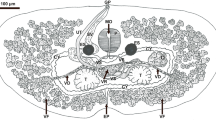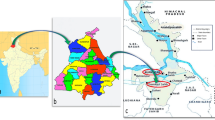Abstract
Ornamental fish are becoming increasingly popular, but the lack of knowledge regarding their various diseases is a major challenge. Skin diseases commonly found in freshwater fish include black spot disease (BSD), which is characterized by melanin deposits around the metacercariae of some trematode species. Since BSD remains poorly understood, this study describes an outbreak of BSD in Etroplus maculatus raised in outdoor ponds at a Brazilian fish farm. Metacercariae samples were collected, examined, and subjected to molecular phylogenetic analysis. The parasites were conspecific to an unnamed species, Crassiphiala lineage 5, recently found in Brazilian birds (Megaceryle torquata). Sequences obtained for longifurcate cercariae of the planorbid snail Biomphalaria straminea from the same region were identical to our metacercariae of Crassiphiala sp. These results suggest that Biompahalaria snails are likely an intermediate host of this parasite on farms where E. maculatus was found to be infected. We provide the first molecular evidence that Crassiphiala are the causative agents of BSD in fish from Brazil. Combatting snails and preventing access of fish-eating birds to outdoor ponds are strategies to control this disease in ornamental fish farms.




Similar content being viewed by others
Data availability
Data is available upon reasonable request from the first author or the corresponding author.
References
Achatz TJ, Pulis EE, Fecchio A, Schlosser IJ, Tkach VV (2019) Phylogenetic relationships expanded diversity and distribution of Crassiphiala spp. (Digenea, Diplostomidae), agents of black spot disease in fish. Parasitol Res 118:2781–2787. https://doi.org/10.1007/s00436-019-06439-y
Barrilli GHC, Moura ENF, Rocha O, Verani JR (2021) The influence of black spot disease on the relative condition factor of Astyanax paranae Eigenmann, 1914 (Characiformes: Characidae) in Brazilian subtropical streams. Acta Sci Biol Sci 43:e56164. https://doi.org/10.4025/actascibiolsci.v43i1.56164
Bush AO, Fernandez JC, Esch GW, Seed JR (2001) Parasitism: the diversity and ecology of animal parasites. Cambridge, United Kingdom
Charo-Karisa H, Ali SE, Marijani E, Ibrahim NA, Trinh TQ, Chadag MV, Benzie JAH (2021) Genetic parameters for black spot disease (diplostomiasis) caused by Uvulifer sp. infection in Nile tilapia (Oreochromis niloticus L.). Aquac 532:736039
Dennis MM, Izquierdo A, Conan A, Johnson K, Giardi S, Frye P, Freeman MA (2019) Scaphanocephalus-associated dermatitis as the basis for black spot disease in Acanthuridae of St. Kitts, West Indies. Dis Aquat Org 137:53–63. https://doi.org/10.3354/dao03419
Duflot M, Gay M, Midelet G, Kania PW, Buchmann K (2021) Morphological and molecular identification of Cryptocotyle lingua metacercariae isolated from Atlantic cod (Gadus morhua) from Danish seas and whiting (Merlangius merlangus) from the English Channel. Parasitol Res 120:3417–3427. https://doi.org/10.1007/s00436-021-07278-6
Faria PMC, Ribeiro K, Almeida CF, Santos FWM, Santos RFB (2016) Aquicultura ornamental: um mercado promissor. Panorama Aquicult 26:24–37
Flores-Lopes F (2014) The occurrence of black spot disease in Astyanax aff. fasciatus (Characiformes: Characidae) in the Guaíba Lake basin, RS, Brazil. Braz J Biol 74:S127–S134. https://doi.org/10.1590/1519-6984.08312
Galazzo DE, Dayanandan S, Marcogliese DJ, McLaughlin JD (2002) Molecular systematics of some North American species of Diplostomum (Digenea) based on rDNA-sequence data and comparisons with European congeners. Can J Zool 80:2207–2217. https://doi.org/10.1139/z02-198
Hoffman GL (1955) Neascus nolfi n. sp. (Trematoda: Strigeida) from cyprinid minnows with notes on the artificial digest recovery of helminths. Am Midl Nat 53:198–204
Hoffman GL (1956) The life cycle of Crassiphiala bulboglossa (Trematoda: Strigeida). Development of the metacercaria and cysts, and effect on the fish hosts. J Parasitol 42:435–444
Kohl ZF, Calhoun DM, Elmer F, Peachey RBJ, Leslie KL, Tkach V, Kinsella JM, Johnson PTJ (2019) Black-spot syndrome in Caribbean fishes linked to trematode parasite infection (Scaphanocephalus expansus). Coral Reefs 38:917–930. https://doi.org/10.1007/s00338-019-01819-3
Kumar S, Stecher G, Tamura K (2016) MEGA7: molecular evolutionary genetics analysis version 7.0 for bigger datasets. Mol Biol Evol 33:1870–1874. https://doi.org/10.1093/molbev/msw054
Lane RL, Morris JE (2000) Biology, prevention, and effects of common grubs (digenetic trematodes) in freshwater fish. NCRAC Technical Bulletins 115:1–6
López-Hernández D, Locke AS, Assis JCA, Drago F, Melo AL, Rabelo ÉM, Pinto HA (2019) Molecular, morphological and experimental-infection studies of cercariae of five species in the superfamily Diplostomoidea (Trematoda: Digenea) infecting Biomphalaria straminea (Mollusca: Planorbidae) in Brazil. Acta Trop 199:105082. https://doi.org/10.1016/j.actatropica.2019.105082
Miura O, Kuris AM, Torchin ME, Hechinger RF, Dunham EJ, Chiba S (2005) Molecular-genetic analyses reveal cryptic species of trematodes in the intertidal gastropod, Batillaria cumingi (Crosse). Int J of Parasitol 35:793–801. https://doi.org/10.1016/j.ijpara.2005.02.014
Niewiadomska, K (2002) Family Diplostomidae Poirier, 1886. In DI Gibson, A Jones, R.A (Eds.). Keys to the Trematoda. London, pp. 167–196
Rezende FP, Motta JDS, Ramos FM, Fujimoto RY, Polese MF, Fernandes G (2021) Sistemas e infraestrutura de produção. In: Rezende FP, Fujimoto RY (eds) Peixes ornamentais no Brasil: mercado, legislação, sistemas de produção e sanidade, Brasilia, p 297
Ronquist F, Teslenko M, van der Mark P, Ayres DL, Hohna S, Larget B, Liu L, Suchard MA, Huelsenbeck JP (2012) MrBayes 3.2: efficient Bayesian phylogenetic inference and model choice across a large model space. Syst Biol 61:539–542. https://doi.org/10.1093/sysbio/sys029
Sándor D, Molnár K, Gibson DI, Székely C, Majoros G, Cech G (2017) An investigation of the host-specificity of metacercariae of species of Apophallus (Digenea: Heterophyidae) in freshwater fishes using morphological, experimental, and molecular methods. Parasitol Res 116:3065–3076. https://doi.org/10.1007/s00436-017-5617-5
Thatcher VE (2006) Amazon fish parasites, 2nd edn. Pensoft Publishers, Bulgaria, p 509
Tkach VV, Littlewood DTJ, Olson PD, Kinsella JM, Swiderski Z (2003) Molecular phylogenetic analysis of the Microphalloidea Ward, 1901 (Trematoda: Digenea). Syst Parasitol 56:1–15. https://doi.org/10.1023/A:1025546001611
Valenti WC, Barros HP, Moraes-Valenti P, Bueno GW, Cavalli RO (2021) Aquaculture in Brazil: past, present and future. Aquacult Reports 19:100611
Acknowledgements
This work was supported in part by the National Council for Scientific and Technological Development (CNPq; research scholarship to HAP).
Funding
This work was supported in part by the National Council for Scientific and Technological Development (CNPq; research scholarship to HAP).
Author information
Authors and Affiliations
Contributions
Danimar López-Hernández: acquisition of data, performed the experiments, analysis, and interpretation of results, and for drafting the article.
Marcia Pimenta Leibovitz: analysis and interpretation of results, drafting the article, and revising it critically for important intellectual content.
Hudson Alves Pinto: conception and design of the study, analysis, and interpretation of results, revising it critically for important intellectual content, and final approval of the version to be submitted.
Carlos Augusto Gomes Leal: conception and design of the study, supervision of the study, funding acquisition, revising it critically for important intellectual content, and final approval of the version to be submitted.
Corresponding author
Ethics declarations
Ethics approval
The study was approved by the Local Ethics Committee in Animal Experimentation (CEUA-UFMG, protocol 68/2017).
Consent to participate
This is not applicable to the present manuscript.
Consent for publication
All authors reviewed and approved the final version of the manuscript.
Conflict of interest
The authors declare no competing interests.
Additional information
Section Editor: Guillermo Salgado-Maldonado
Publisher’s note
Springer Nature remains neutral with regard to jurisdictional claims in published maps and institutional affiliations.
Rights and permissions
Springer Nature or its licensor (e.g. a society or other partner) holds exclusive rights to this article under a publishing agreement with the author(s) or other rightsholder(s); author self-archiving of the accepted manuscript version of this article is solely governed by the terms of such publishing agreement and applicable law.
About this article
Cite this article
López-Hernández, D., Leibowitz, M.P., Pinto, H.A. et al. First report of Crassiphiala sp. (Trematoda: Diplostomidae) as an etiological agent of black spot disease in commercial ornamental fish from Brazil. Parasitol Res 122, 1037–1042 (2023). https://doi.org/10.1007/s00436-023-07794-7
Received:
Accepted:
Published:
Issue Date:
DOI: https://doi.org/10.1007/s00436-023-07794-7




